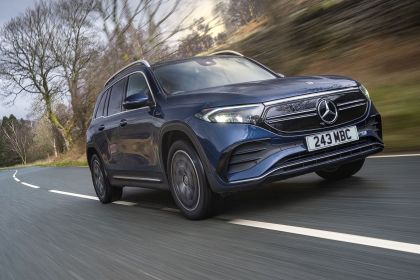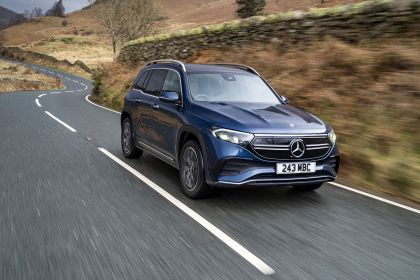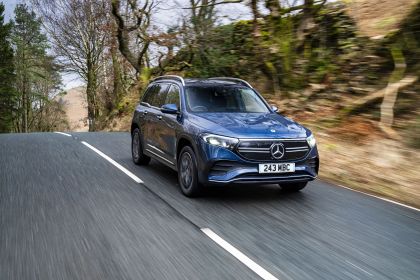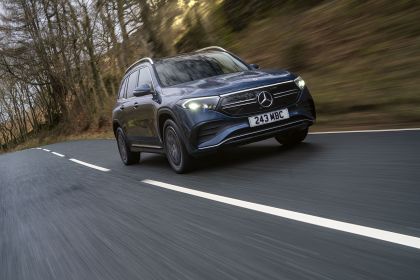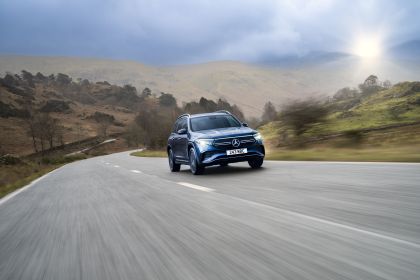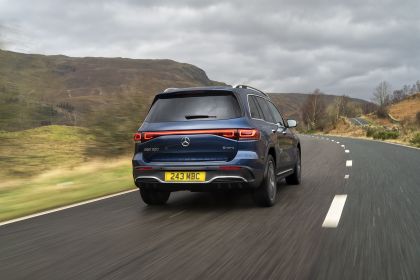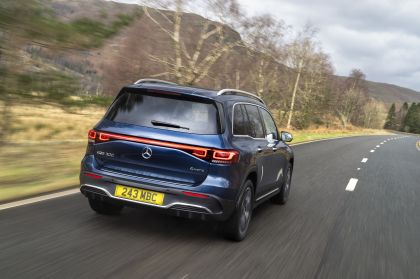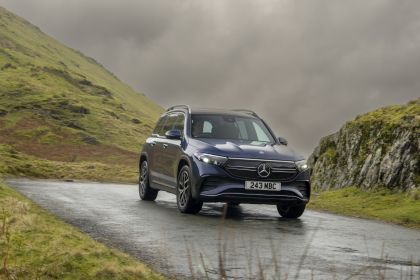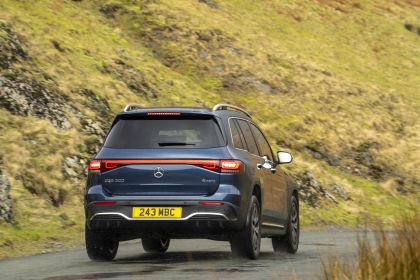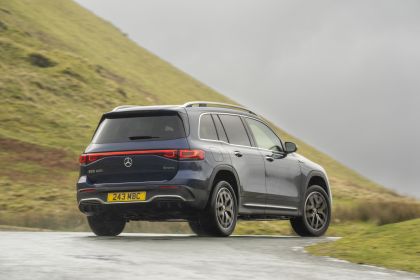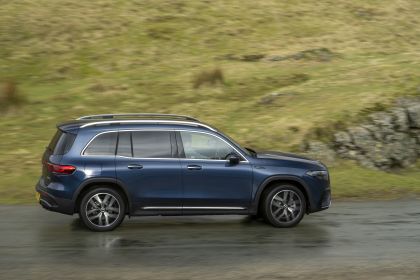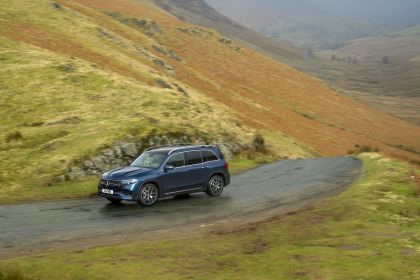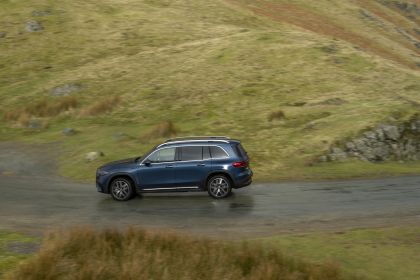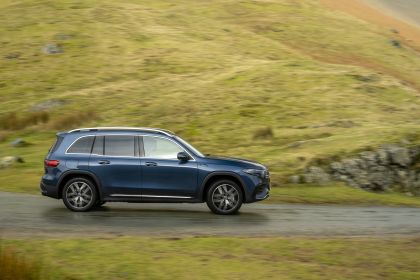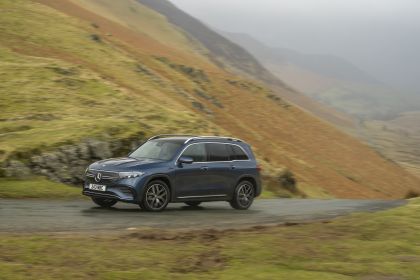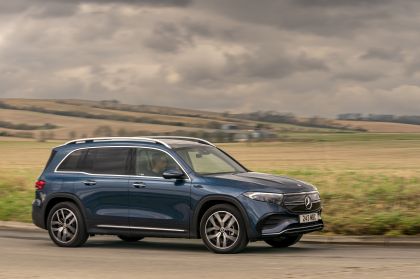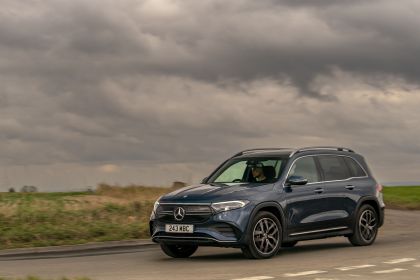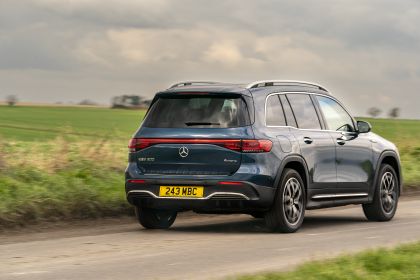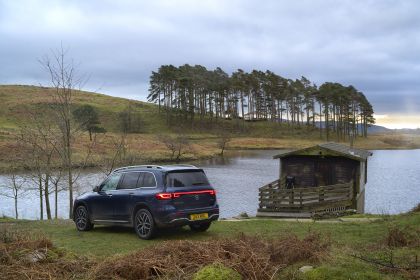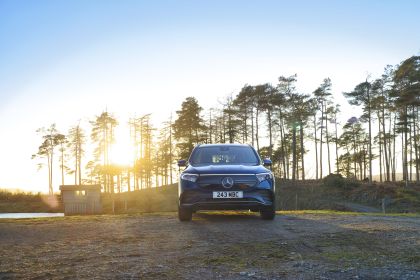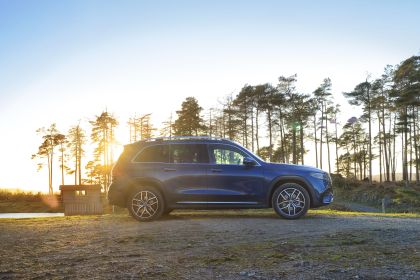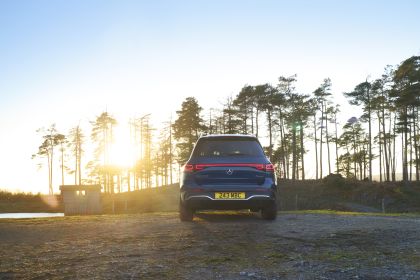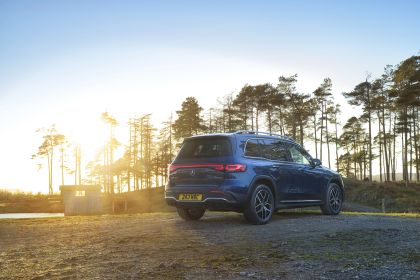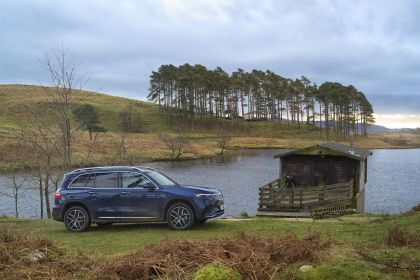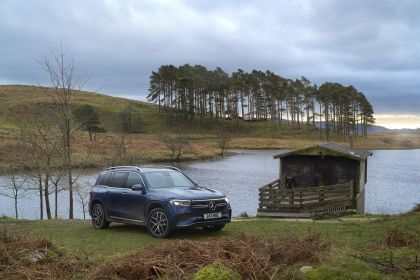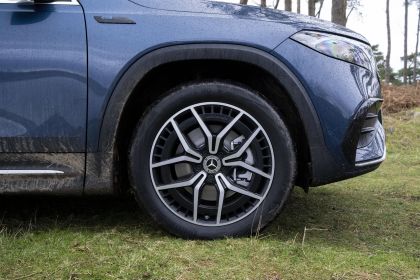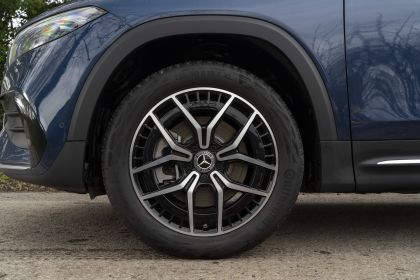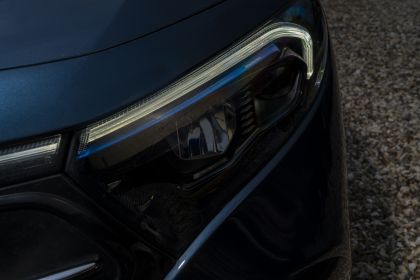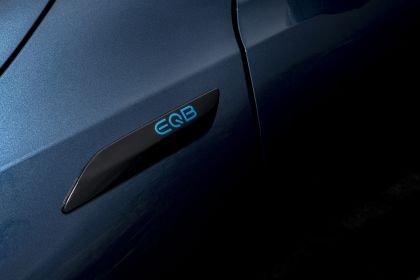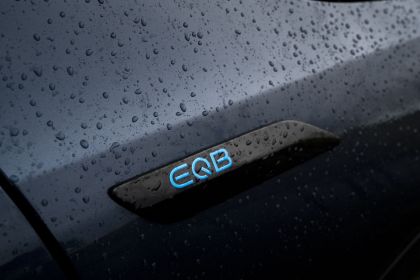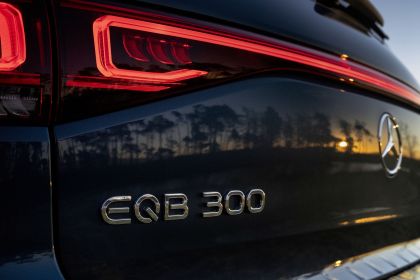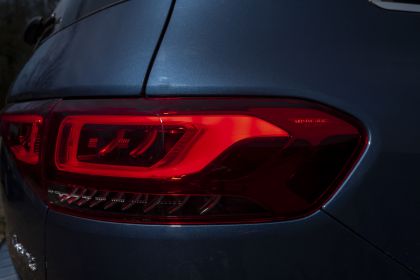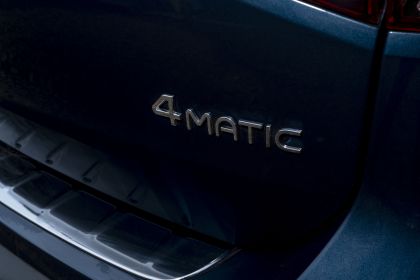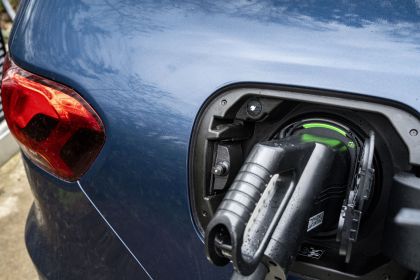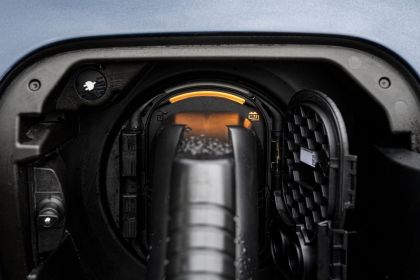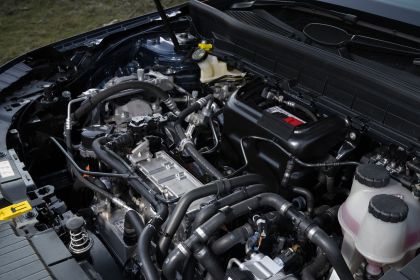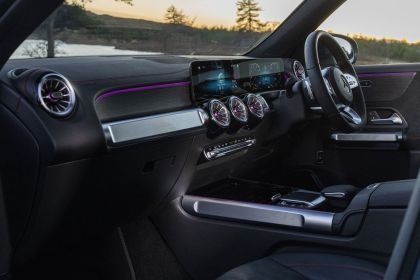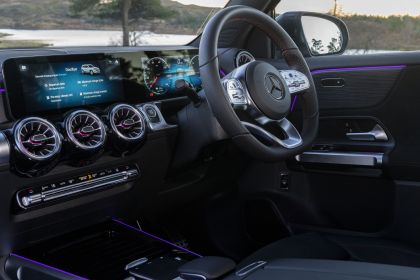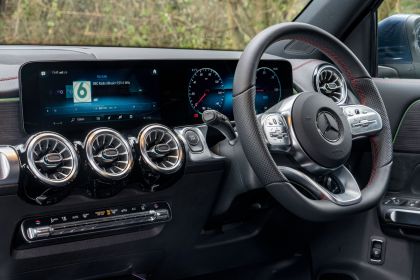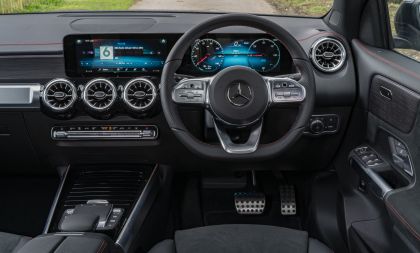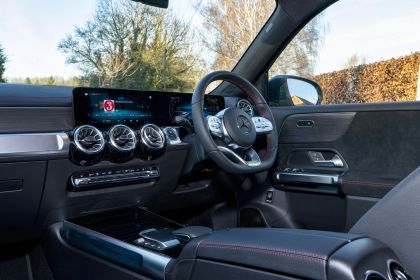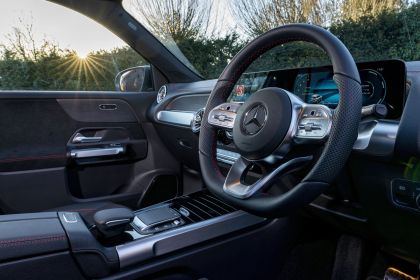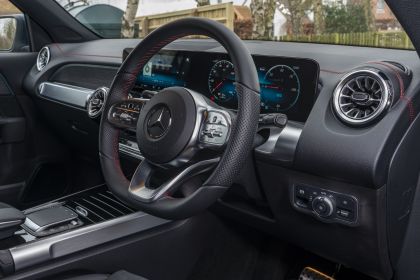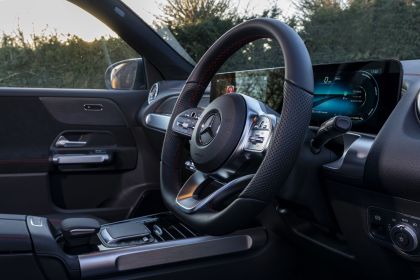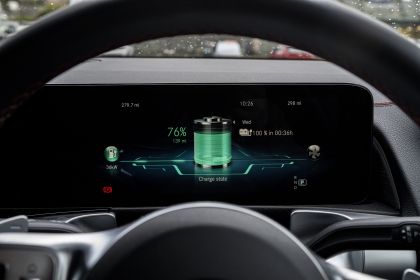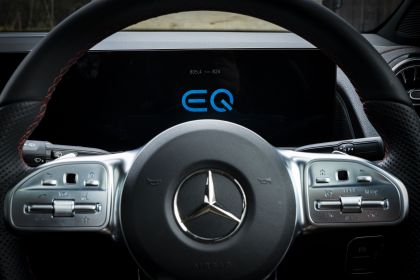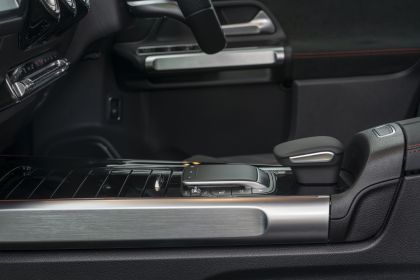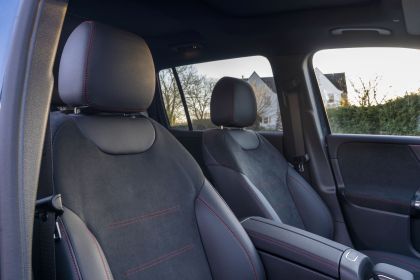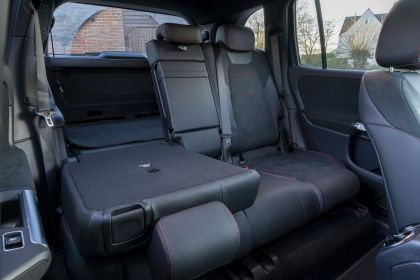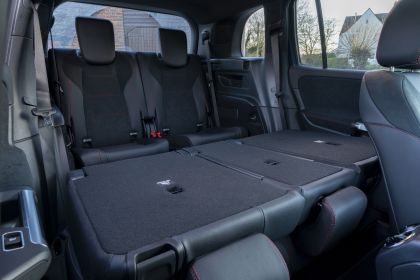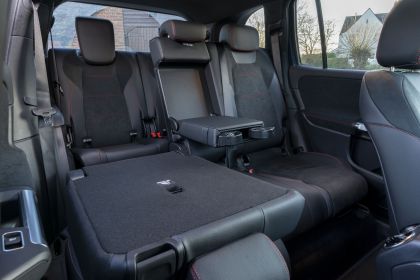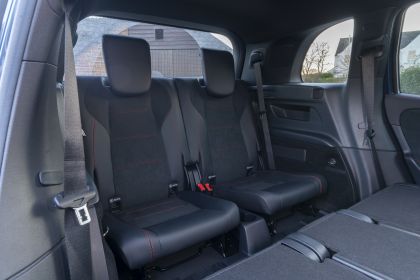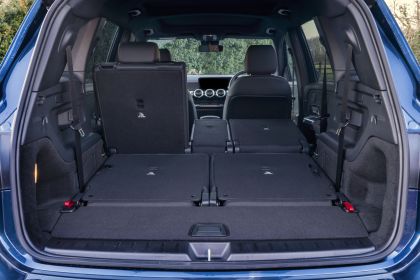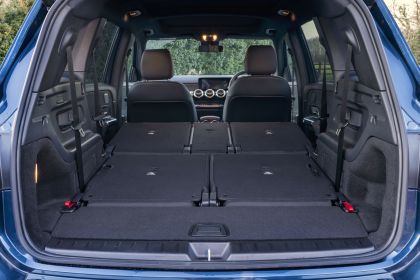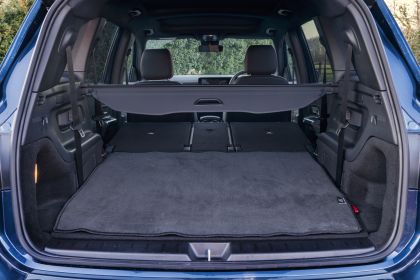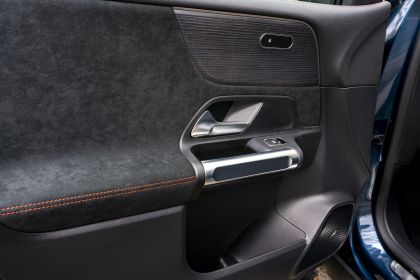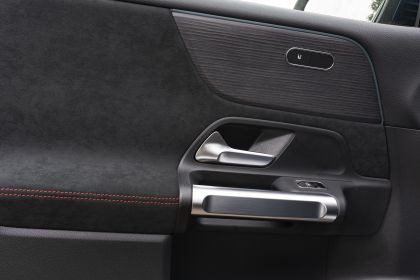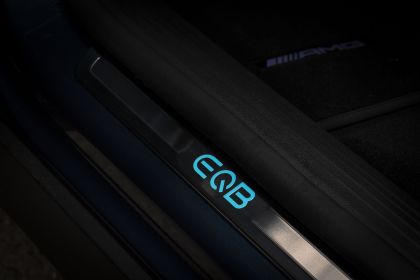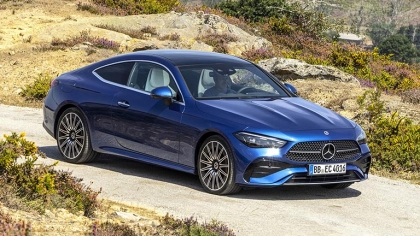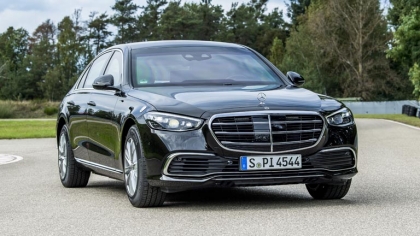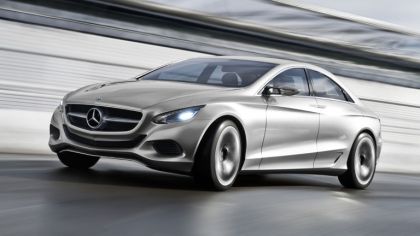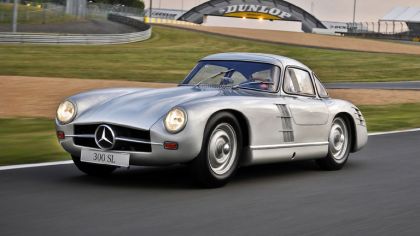Whether it's for a large nuclear family or a small extended family: as a seven-seater, the new EQB offers space for many family configurations and a wide variety of transport needs. This gives it an exceptional position among compact electric cars. The two seats in the third row can be used by people up to 1.65 metres tall, and child seats can also be fitted there. The new EQB will launch in Europe and China at the end of the year, followed by the US market launch in 2022. After the EQA, it is already the second all-electric compact car from Mercedes-EQ. The powerful and efficient electric drive, clever recuperation and predictive Navigation with Electric Intelligence are just some of the features that link it to the EQA.
The electric initiative from Mercedes-Benz Cars is accelerating as fast as the Mercedes-EQ models themselves: with the EQA, EQB, the electric business saloon EQE and the luxury saloon EQS, a total of four new models from Mercedes-EQ are being introduced in 2021, plus the Concept EQT as a harbinger of a new high level of quality in the small van segment. The Mercedes-Benz plug-in hybrid family, currently consisting of more than 20 model variants, is being renewed with electrified derivatives of the C-Class and the S-Class. For 2021, Mercedes-Benz Cars expects to increase the xEV share, i.e. of plug-in hybrids and fully electric vehicles, to around 13 percent. In addition, mild hybrids with a starter-generator and 48-volt system are conquering the product range, especially of the Group's luxury vehicles.
"With the new EQB we have designed an iconic electric SUV which incorporates the square forms of our off-roaders and projects them into the future. Its significant silhouette is combined with futuristic elements such as the black panel front to create the extraordinary look of this vehicle", says Gorden Wagener, Chief Design Officer of the Daimler Group.
In Europe, the all-electric compact SUV will be launched as the EQB 300 4MATIC with 168 kW and as the EQB 350 4MATIC with 215 kW. The ranges according to WLTP are 419 kilometres in each case. Further variants to meet specific customer requirements will follow, including a particularly long-range version.
Generous space and variable, level boot
The EQB enriches the successful Mercedes compact car family and is closely related to two models in particular: to the EQA, whose advanced drive technology it shares, and to the GLB compact SUV. This is where the long wheelbase (2829 millimetres), the spacious and variable interior and the optional third row of seats with two additional individual seats come from.
The dimensions of the five-seater: 4684/1834/1667 millimetres (length/width/height). Space is generous. The headroom in the first row of seats is 1035 millimetres, in the second it is 979 millimetres for the five-seater. At 87 millimetres, the knee space in the rear of the five-seater reaches a comfortable level. The boot is level and spacious: the load volume of 495 to 1710 or 465 to 1620 litres (figures for five- and seven-seaters respectively) has the qualities of a Mid-range station wagon. The backrests of the seats in the second row can be adjusted in several stages as standard, and this row features fore/aft adjustment of 140 millimetres as an option. This enables the boot to be enlarged by up to 190 litres and put to versatile use.
As an option, the EQB has a third row of seats comprising two extra individual seats. The seats offer people up to a height of 1.65 metres a comfortable amount of space. Extensive safety features include retractable head restraints, seat belts with belt tensioners and force limiters on all outer seats and a side windowbag that also covers passengers in the third row. A total of up to four child seats can be fitted in rows two and three, plus one more in the front passenger seat. To increase luggage space, the third-row seats can be lowered flush into the load floor.
Electro design aesthetics brimming with character
The EQB interprets Mercedes-EQ's Progressive Luxury in an edgy and particularly characterful way. It features the characteristic Mercedes-EQ black panel grille with central star. A further distinctive design feature of the all-electric world of Mercedes-EQ vehicles is the continuous light strip at the front and rear. A horizontal fibre-optic strip connects the daytime running lights of the full-LED headlamps, ensuring a high level of recognisability both in daylight and at night. The inside of the headlamps is finished to a high level of quality, detail and precision. Blue colour highlights within the headlamp reinforce the signature Mercedes-EQ appearance.
The function-oriented greenhouse with upright windscreen makes the comfortable interior possible. Circumferential and protective cladding elements structure the overall proportion. The muscular and sensuously modelled vehicle shoulder dominates the side view, which is further enhanced by the rise of the beltline. Outwardly positioned wheels give the EQB a powerful character and confident stance on the road. Exclusive to this model are light-alloy wheels in a bi- or tri-colour design, up to 20 inches in size, in some cases with rosé gold-coloured or blue decorative trim.
The LED tail lights merge seamlessly into the tapering LED light strip. This underlines the horizontal sense of width of the EQB in the rear view. In addition, the number plate is placed on the bumper, which allows for a beautifully sculpted tailgate. The studded roof rails underline the high utility value of the new EQB.
The large body of the dashboard has a cut-out in the driver and passenger area. The driver faces a Widescreen Cockpit, with control and display via MBUX (Mercedes-Benz User Experience). The robust character of the interior is underlined by tubular elements in an aluminium look. They sit as handles in the doors, in the centre console and in the instrument panel on the passenger side.
Depending on the design and equipment line, a spectacular backlit trim piece and rosé gold-coloured decorative elements on the air vents, seats and vehicle key provide clues to the electric character in the interior of the EQB. The instruments, with their electric car-specific displays, pick up on the same colour scheme with rosé gold-coloured and blue highlights.
The EQB achieves a very good Cd value from 0.28. The frontal area A totals 2.53 m2. Among the most important aerodynamic measures are the completely closed cooling air control system in the upper section, the aerodynamically efficient front and rear aprons, a very smooth, almost completely enclosed underbody, specially optimised Aero wheels and specifically adapted front and rear wheel spoilers.
Efficient driving pleasure and Navigation with Electric Intelligence
ECO Assist offers a recuperation process optimised to the particular situation. It incorporates navigation data, traffic sign recognition and information from the vehicle sensors into its efficiency strategy. Anticipatory driving saves power, thereby extending the range.
The standard Navigation with Electric Intelligence also contributes to the effortless handling of the EQB in everyday life. This calculates the fastest route to the given destination. On the basis of continual range simulations, the system makes allowance for any necessary charging stops as well as for numerous other factors, such as the topography and the weather. It is also able to react dynamically to changes, for instance in the traffic situation or personal driving style. In addition, the Navigation with Electric Intelligence ensures that the high-voltage battery is brought to an optimal charging temperature before a planned charging stop, if required.
Sophisticated charging technology, large network and compensation through green electricity
At home or at public charging stations, the EQB can be conveniently charged at up to 11 kW with alternating current (AC) using the onboard charger. The charging time required for a full charge depends on the available infrastructure and the country-specific vehicle equipment. Charging at a Mercedes-Benz Wallbox is considerably faster than at a domestic power socket.
And it is of course even faster at direct current (DC) fast-charging stations. Depending on the SoC (State of Charge) and the temperature of the high-voltage battery, the EQB charges at a corresponding charging station with a maximum power of up to 100 kW. The charging time is then just over 30 minutes from 10-80 percent SoC. And after just 15 minutes, electricity is recharged for up to another 150 kilometers (WLTP). For AC and DC charging, the EQB is equipped as standard in Europe and the USA with a CCS (Combined Charging Systems) connector in the right-hand side panel.
Via Mercedes me Charge, EQB drivers will be able to use one of the most extensive charging networks in the world: this currently comprises more than 600,000 AC and DC charging stations across 31 countries. Mercedes me Charge allows Mercedes-EQ customers convenient use of the charging stations of various providers, while they also benefit from an integrated payment function with simple billing processes. With the EQB, one year of Mercedes me Charge is included.
In Europe, Mercedes-Benz guarantees by means of high-quality certificates of origin that electricity from renewable energies is fed into the grid for charging volumes that flow via Mercedes me Charge. With Mercedes me Charge, customers can charge at more than 250,000 public charging stations across Europe, where Mercedes-Benz ensures subsequent compensation through green electricity.
Cooperative support for the driver and high level of crash safety
The EQB features intelligent driving assistance systems with cooperative support for the driver. Active Lane Keeping Assist and Active Brake Assist are fitted as standard. In many critical situations, the latter has the ability to prevent a collision or reduce its severity with autonomous braking. The system is also able to brake for stationary vehicles and crossing pedestrians at typical city speeds. The enhanced functions of the Driving Assistance Package include, for example, the turning manoeuvre function, the emergency corridor function, the exit warning function alerting the driver to approaching cyclists or vehicles, and a warning when pedestrians are detected near zebra crossings.
The EQB is also a true Mercedes when it comes to passive safety. Building on the robust bodyshell structure of the GLB, the body of the EQB was adapted to the special requirements of an electric car. The battery sits within a frame made out of extruded sections. This takes on a structural function which until now was maintained by the cross members in the underfloor. A battery guard in the front area of the battery is able to prevent the energy storage unit from being pierced by foreign objects.
Of course, the EQB had to pass the brand's usual extensive crash test programme. Stringent requirements for the battery and all components carrying electrical current also apply.
The EQB in the global production network
Production of the EQB will start in October 2021 at two locations within the Mercedes-Benz Cars global production network: at the Hungarian Mercedes-Benz plant in Kecskemét for the global market and at the German-Chinese joint venture BBAC in Beijing for the local market. Preparations, including staff qualification processes and reconstruction work, have already commenced at the plants. The EQB compact SUV will be the first all-electric production vehicle from Hungary and will complement the plug-in hybrid portfolio produced there.
Since it commenced production in 2012, the Hungarian Mercedes-Benz plant has continually increased in importance within the global production network of Mercedes-Benz Cars. In addition to digital networking, the strengths of the compact car production network include direct exchange with the lead plant for compact cars in Rastatt, Baden-Württemberg.
Exterior design
The EQB interprets Mercedes-EQ's Progressive Luxury in an edgy and particularly characterful way. It features the characteristic Mercedes-EQ black panel grille with central star. A further distinctive design feature of the all-electric world of Mercedes-EQ vehicles is the continuous light strip at the front and rear.
Key features of the front-end design:
- The progressive and width-accentuated black panel front makes for a self-confident appearance.
- A horizontal fibre-optic strip connects the daytime running lights of the full-LED headlamps, ensuring a high level of recognisability both in daylight and at night.
- The inside of the headlamps is finished to a high level of quality, detail and precision.
- Blue colour highlights within the headlamp reinforce the signature Mercedes-EQ appearance.
- The stretched bonnet has discreetly indicated power domes.
Key features of the side design:
- The EQB impresses with its balanced overall proportions, with short overhangs front and rear.
- The function-oriented greenhouse with upright windscreen makes the comfortable interior possible. Circumferential and protective cladding elements structure the overall proportion.
- The muscular and sensuously modelled vehicle shoulder dominates the side view, which is further enhanced by the rise of the beltline.
- Outwardly positioned wheels give the EQB a powerful character and confident stance on the road.
- Exclusive to this model are light-alloy wheels in a bi- or tri-colour design, up to 20 inches in size, in some cases with rosé gold-coloured or blue decorative trim.
- The studded roof rails underline the high utility value of the new EQB.
Key features of the rear-end design:
- The LED tail lights merge seamlessly into the tapering LED light strip. This underlines the horizontal sense of width of the EQB in the rear view.
- The number plate has been moved to the bumper, allowing for a beautifully shaped tailgate.
- The standard-fit reversing camera is integrated into the automatically pivoting Mercedes-Benz star.
Interior design
The robust character of the interior is underlined by tubular elements in an aluminium look. They sit as handles in the doors, in the centre console and in the instrument panel on the passenger side. Depending on the design and equipment line, a spectacular backlit trim piece and rosé gold-coloured decorative elements on the air vents, seats and vehicle key provide clues to the electric character in the interior of the EQB. The instruments, with their electric car-specific displays, pick up on the same colour scheme with rosé gold-coloured and blue highlights.
The large body of the dashboard has a cut-out in the driver and passenger area. The driver faces a Widescreen Cockpit, with control and display via MBUX (Mercedes-Benz User Experience).
MBUX can be individually configured with the help of various options. Key advantages of the system: the powerful computer, brilliant screens and graphics, customisable presentation, full-colour head-up display, navigation with augmented reality and learning software and voice control activated by the keyword "Hey Mercedes".
The information in the instrument cluster and on the media display is easily legible on the large, high-resolution screens. An emotive presentation underlines the comprehensibility of the intuitive control structure and offers brilliant graphics in superb visual quality. The Mercedes-EQ tile in the media display can be used to call up menus relating to charging options, electrical consumption and energy flow. The right-hand display within the instrument cluster is a wattmeter rather than a rev counter. The upper section shows the percentage of power, the lower section the recuperation. The left-hand instrument can be used to show whether the destination can be reached without an interim charging stop. The colours change according to the driving situation: during a boost process, for example, the display changes to white.
Depending on mood, or to match the particular interior, the user has a choice of four different styles. The Progressive variant includes a special Mercedes-EQ colour scheme:
- Modern Classic is the evolution of the classic display style in an elegant-light and exquisite materiality.
- Sport has a high-tech turbine look with sporty black/yellow contrasts.
- Progressive represents a modern interpretation of an instrument cluster in the digital display world. In the interests of reducing the display to what is strictly necessary and in order to allow focused intake of information, the display values of the round instruments for speed and power are displayed dynamically only in the required range in each instance. In the EQB, the colour scheme here is pure blue/rosé gold-coloured.
- Discreet mode greatly reduces the information and thereby helps the driver to relax.
Drive system
The EQB starts as the EQB 300 4MATIC with 168 kW and as the EQB 350 4MATIC with 215 kW. The ranges according to WLTP are 419 kilometres in each case. Further variants to meet specific customer requirements will follow, including a particularly long-range version.
An asynchronous motor is used at the front axle. The electric motor, a fixed-ratio transmission with differential, the cooling system and the power electronics form a highly integrated, very compact unit - the electric powertrain (eATS).
In addition, the EQB 300 4MATIC and EQB 350 4MATIC also have an eATS on the rear axle with a newly developed permanently excited synchronous motor. It is extremely compact in design. In a permanently excited synchronous motor, the rotor of the AC motor is fitted with permanent magnets. The magnets - and thus the rotor - follow the rotating alternating current field in the stator windings. The engine is referred to as synchronous because the rotor turns at the same rate as the magnetic field of the stator. The frequency is adapted to the speed demanded by the driver in the frequency inverters of the power electronics. The advantages of this design include high power density, high efficiency and high output consistency.
In the 4MATIC versions, the power demand between the front and rear axles is intelligently regulated 100 times per second, depending on the driving situation. The Mercedes-EQ philosophy is to optimise consumption by using the rear electric motor as often as possible, while the asynchronous motor at the front axle generates only minimal drag losses in partial-load operation.
In overrun mode or during braking, the electric motors become alternators: their mechanical rotation is converted into electrical energy and used to charge the high-voltage battery - a process known as recuperation.
The battery: part of the intelligent thermal management system
The EQB is fitted with a lithium-ion battery with a high energy density. It has a maximum voltage of 420 V and, with a nominal capacity of around 190 Ah, has a usable energy content of 66.5 kWh.
The battery is made up of five modules and is located underneath the passenger compartment in the middle of the vehicle. An aluminium housing as well as the body structure of the vehicle itself protect the component from potentially touching the ground and against loose chippings. The battery housing is part of the vehicle structure and thus an integral part of the crash concept.
The battery is part of the intelligent thermal management system of the EQB. To ensure that it is always kept within the optimum temperature range, it can be cooled or heated as required via a coolant-fed plate underneath the battery.
If Navigation with Electric Intelligence is activated, the battery may also be pre-heated or cooled while driving in order to ensure that it is within the ideal temperature window for a rapid charging station. On the other hand, if the battery is cold when the car reaches the rapid charging station, a considerable proportion of the charging capacity will initially be used simply to warm it up. The net effect is to optimise the charging time - important, as a means of significantly shortening the charging stop.
As for all other high-voltage batteries, Mercedes-Benz issues a battery certificate, thus providing a performance warranty. This is valid for eight years or a distance covered of 160,000 kilometres and guarantees a properly functioning high-voltage battery: the certificate also covers capacity loss in the battery.
Charging management: CCS charging socket for alternating current as well as direct current
At home or at public charging stations, the EQB can be conveniently charged at up to 11 kW with alternating current (AC) using the onboard charger. The charging time required for a full charge depends on the available infrastructure and the country-specific vehicle equipment. Charging at a Mercedes-Benz Wallbox is considerably faster than at a domestic power socket.
And it is of course even faster at direct current (DC) fast-charging stations. Depending on the SoC (State of Charge) and the temperature of the high-voltage battery, the EQB charges at a corresponding charging station with a maximum power of up to 100 kW. The charging time is then 32 minutes from 10-80 per cent SoC. And after just 15 minutes, electricity is recharged for up to another 300 kilometers (WLTP). For AC and DC charging, the EQB is equipped as standard in Europe and the USA with a CCS (Combined Charging Systems) connector in the right-hand side panel.
Recuperation
ECO Assist coaches the driver with messages when the accelerator can be released, for instance because a speed limit is approaching, and with functions such as gliding and specific control of recuperation. For this purpose, navigation data, traffic sign recognition and information from the intelligent safety assistants (radar and stereo camera) are linked and processed.
ECO Assist predictively computes the driving situation when deciding whether to drive with the lowest resistance or whether to recuperate. Examples include dips in the road, brows or speed limits ahead, which the system recognises from the map data. It takes into account the course of the road (bends, junctions, roundabouts, gradients), speed limits and distance to vehicles ahead in its driving recommendations and efficiency strategy.
Within the limits of the system, ECO Assist controls the overrun according to the situation as soon as the driver's foot leaves the accelerator. The driver is also given a visual prompt to do this: by showing a "foot off the accelerator" symbol in the media display (or if available, in the head-up display). At the same time, a diagram gives the driver the reason for the recommendation (e.g. "Junction ahead" or "Gradient ahead").
The EQB offers several variants of energy recovery by means of recuperation. In general terms the process involves recharging the high-voltage battery by converting the mechanical rotation in overrun mode or during braking into electrical energy.
The driver can select the recuperation function manually using paddles behind the steering wheel. The two paddles behind the steering wheel can be used to influence the recuperation level. The paddle on the left increases the level of recuperation, the paddle on the right reduces it. The driver can see the selected setting in the instrument cluster. The following recuperation stages are available: DAuto (situation-optimised recuperation via ECO Assist), D+ (gliding), D (weak recuperation) and D- (medium recuperation). If the DAuto function is selected, this mode is retained when the unit is restarted. To stop, the driver must activate the brake as normal, whatever the recuperation stage.
Navigation with Electric Intelligence
Which way? And where is the next charging station? The classic responsibilities of a co-driver. In the new EQB, this job is handled by a series of intelligent assistants. Navigation with Electric Intelligence calculates the fastest route currently possible, taking into account various factors. If a charging stop is required, the driver will be directed to a charging station.
As far as Navigation with Electric Intelligence is concerned, the name says it all. It takes numerous factors into account in an intelligent way to plan the fastest route, including charging stops, and can even react dynamically to changes, for example to traffic hold-ups. While a conventional range calculator lives from past data, the Navigation with Electric Intelligence system in the EQB looks into the future.
The calculation of the route takes into account, for example, the electric range, the current electrical consumption, the topography of the proposed route (due to the energy requirement) and the temperatures along the way (due to the duration of the charge). Further factors include the traffic situation along the planned route, as well as the available charging stations to be found there and their capacity. The customer does not necessarily always have to take on board a full charge, but will be given a specific recommendation as to the required charging time at the charging station. The charging station stops will be planned in the way that is most favourable for the overall travelling time: in certain circumstances it may be that two brief charges at a higher charging capacity will be faster than one long charge.
If the range is becoming critical, the active range monitoring system will give advice such as "Air conditioning off" or "Select ECO mode". In addition, in ECO mode the system will calculate a more efficient driving speed with which the next charging station or the destination can be reached as planned, and display this in the speedometer. If DISTRONIC is activated, this speed will be set automatically. In this mode the system will also switch to an intelligent operating strategy for the ancillary consumers in order to reduce their power requirement and thus increase the range as the situation requires.
Route planning can be undertaken in advance in the Mercedes me App. Assuming this is then confirmed in the vehicle's navigation system before the journey starts, the route will be reloaded using this latest information. In principle, the data are updated before the start of each journey and then every two minutes.
The driver is also able to make individual adjustments to the Navigation with Electric Intelligence function. In the basic setting, for example, the battery capacity is exploited to a large extent. However, a personal safety buffer can be selected for the remaining range, so that the EQB will, for example, factor into the journey a desired SoC of at least 10 percent at the charging station or an SoC of 50 percent on arrival at the destination.
Aerodynamics
The EQB achieves a very good value with a Cd value from 0.28. The frontal area A totals 2.53 m2. Among the most important aerodynamic measures are the completely closed cooling air control system in the upper section, the aerodynamically efficient front and rear aprons, a very smooth, almost completely enclosed underbody, specially optimised Aero wheels and specifically adapted front and rear wheel spoilers.
The aerodynamic development of the EQB was largely undertaken digitally. The ensuing measurements undertaken in the wind tunnel confirmed the high quality of the numerical simulation. The EQB builds on the very good aerodynamic basis of the GLB. A new aerodynamic setup was necessary due to the new bumpers and the resulting different diffuser angle. Airflow separation at the front wheels has been reduced by the shape of the bumper and the design of the wheel spoilers with their wedge-shaped profiles, which were specially developed for the EQB.
The underbody panelling is also new. As an electric vehicle the EQB has no need for a transmission tunnel, exhaust system and fuel tank, these being replaced by a smooth-surfaced battery. The air flow along the underside of the body is guided virtually unimpeded from the front apron over the engine compartment panelling and three main floor panels through to the similarly enclosed rear axle and diffuser trim. Due to the longer wheelbase compared to the EQA and the slightly different battery position, the EQB has an additional trim piece in the main floor. This closes the gap between the battery and the axle fairing. In general, a lot of attention has been paid to details: the ribs that give strength to the underfloor panelling, for example, all run front to back.
The cooling-air intake is also to a design specifically for an electric vehicle: since the EQB has less need of cooling than a car with a combustion engine, it was possible to completely blank off the upper section of the cooling-air intake. The lower section features adjustable radiator shutters.
The aerodynamic measures at a glance:
- Aerodynamic design of front and rear aprons
- Wheel spoilers with wedge-shaped profile at the front, wheel spoilers at the rear
- Cooling-air control system in the lower section of the front apron, smooth panel enclosing upper air intake
- Improved sealing of the radiator area to ensure efficient use of the cooling air
- Sealing in the vicinity of the headlamps
- Aerodynamically and aeroacoustically optimised outside mirrors
- Large roof spoiler, side spoilers and air flow break-away edges in the tail lights
- Optimised underbody panelling concept including large trim panels enclosing engine compartment, main floor, rear axle, diffuser and spring links
- Additional panelling behind the battery to improve the flow around the rear axle for the larger wheelbase of the EQB
- Aerodynamically optimised wheels (many enclosed surfaces, minimal concavity, openings in the inner section) and tyres for all sizes of wheel.
Climate control
With automatic climate control as standard, the EQB offers the same high level of climate comfort as every Mercedes-Benz. For this it features a sophisticated thermal management system with a heat pump as standard. With its numerous innovative details, such as the reuse of the waste heat from the electric drive system, the system is configured for exceptional efficiency and thus maximum range. Pre-entry climate control also ensures that EQB drivers have no need to scrape the windscreen in the morning, nor to climb into a freezing cold vehicle. And even in hot summer temperatures, the interior is cooled to a pleasant level before starting a journey.
It is possible to set the pre-entry climate control for the interior of the EQB before starting. This function is controlled directly via MBUX or via the Mercedes me App. Making use of pre-entry climate control during the charging process helps to preserve range, since the energy requirement is supplied through the charging current and does not impinge on the range.
Pre-entry climate control uses target values as a basis. This means that when the driver enters a departure time, the EQB is pre-conditioned to the preset temperature in time for the start of the journey. The driver can do this either individually for each journey and every stretch of the journey, or with the help of a weekly profile. Pre-entry climate control is also activated automatically for five minutes as soon as the vehicle is unlocked using the key. When pre-entry climate control, which can run for a maximum of one hour, starts or comes to an end, the driver receives a corresponding push notification.
In ECO mode the system will also switch to an intelligent operating strategy for the ancillary consumers. This reduces the power requirement, thereby increasing the range to suit the particular situation.
Efficient thermal architecture reduces energy requirement
The EQB features a sophisticated thermal architecture that includes a heat pump as standard. The system operates very efficiently: the waste heat from the electric drive system (inverter and electric motor) can be used to heat the interior. This reduces drastically the draw on battery power for the heating system, thus increasing the range.
A heat pump - a familiar concept from domestic heating systems - transports the warmth from a low to a higher temperature level. This means that "cold thermal energy", which occurs particularly frequently in electric vehicles, can be used to heat the interior. An overview of the operating mechanism of the EQB's heat pump:
- Efficient reheating with air recirculation: a high proportion of recirculated air means that less (fresh) air has to be heated. To reduce the tendency for the windows to mist up, the vehicle cools the recirculating air, thereby removing moisture. The heat extracted is fed back into the interior via the water-cooled condenser and the heat exchanger. In other words, the heat is recycled.
- Use of waste heat from the electric powertrain.
- Use of waste heat from the high-voltage battery: if the temperature of the battery rises above a defined threshold value, the waste heat can be used to heat the interior.
Low noise and vibration levels (NVH)
The development goal for the EQB was to create a balance between noise and ride comfort at a high level. A particular focus of this work was on the noise from the drive system and the integration of the electric powertrain. Components with a relevance to NVH were configured accordingly during the digital development phase, checked in the hardware phase on test rigs and only then integrated into the vehicle. As when a house is built, efforts were concentrated first on the body-in-white/platform and then on the interior fit-out/insulation, since the isolation or immediate encapsulation of the electric drive unit is demonstrably more effective than damping measures in the interior. The acoustic insulation measures include an enclosed passenger compartment, efficient damping systems on the metal surfaces and acoustically effective trim elements.
The single-speed transmission that forms an integral part of the electric powertrain at the front axle (eATS) operates particularly smoothly thanks to the improved microgeometry of the gearing. NVH measures on the electric powertrains were incorporated into the EQB at an early stage of component development. The power electronics unit, for example, was reinforced and secured firmly to the housing.
In an electrically powered vehicle, the low-frequency background noise associated with a combustion engine is missing, which means that high-frequency noises can become more apparent. The front and rear axle drives of the EQB have therefore been isolated at several points. Components such as the supporting frame at the front axle, the rear-axle subframe and even the rubber bushings were developed in tandem with the digital development phase and continually optimised. These efforts ensure that no irritating noises are perceptible inside the vehicle.
Ancillary components, too, were significantly improved with respect to noise and vibration comfort. The air-conditioning compressor, for example, together with the front powerpack, was isolated from the supporting frame by means of rubber-bonded metal elements. In order to reduce structure-borne sound, the air-conditioning pipes were modified to follow the rigid elements in the bodyshell, and the bearing points isolated as far as possible. In addition, the operating strategy of the air-conditioning compressor avoids engine speeds that could have a detrimental impact on the noise level in the interior. This has no effect on climate comfort.
Low road noise thanks to targeted improvements in rigidity and an ingenious bearing concept
In order to reduce road and tyre noise, the engineers introduced a compact, shear-resistant integral mount which has significantly increased the introductory rigidity at the guide bearing of the front axle. The subframe of the multi-link rear axle is furthermore elastically isolated by rubber bushings. The front subframe connection is integrated into the C-ring structure and therefore has the necessary rigidity for isolation. A cross-member is integrated into the multifunction recess to increase the introductory rigidity of the rear subframe connection.
Low road and tyre noise is an important factor in terms of ride comfort, particularly when driving on country roads. As well as on the configuration of the bodyshell structure and the sound insulation, development work focused on the dynamic transmission characteristics of the various axle components and elastomer bearings. The redesigned front axle subframe allows the connection rigidity for the suspension strut and brake to be significantly increased. Subframe mounts are used in all instances for the rear axle. In conjunction with the reinforcements introduced at the various connection points, this reduces the intrusion of noise. The bearing concept used in the case of the multi-link axle allows greater longitudinal vibration damping, while the dynamic transmission in a vertical direction remains limited.
Driving assistance systems
The EQB features intelligent driving assistance systems with cooperative support for the driver. The enhanced functions of the Driving Assistance Package include, for example, the turning manoeuvre function, the emergency corridor function, the exit warning function alerting the driver to approaching cyclists or vehicles, and a warning when pedestrians are detected near zebra crossings.
Included as standard on board are Active Lane Keeping Assist and Active Brake Assist. In many situations the purpose of the latter is to prevent a collision by autonomous braking, or to mitigate its consequences. The system is also able to brake for stationary vehicles and crossing pedestrians at typical city speeds and even to prevent collisions, depending on the situation.
In certain situations, the EQB is able to drive in partially automated mode. To do this, it keeps a close eye on the traffic situation. Improved camera and radar systems allow it to see far ahead. The EQB also uses map and navigation data for assistance functions. For example, Active Distance Assist DISTRONIC as part of the optional Driving Assistance Package is able to provide route-based support to the driver in numerous situations, and to predictively and conveniently adjust the speed, e.g. when approaching bends, junctions or roundabouts. In doing so, it interacts with ECO Assist. Also on board, for example, is Active Emergency Stop Assist.
The Driving Assistance Package (optional equipment varying according to country and equipment level) includes:
- Active Distance Assist DISTRONIC with the functions:
- braking for stationary vehicles,
- extended automatic restarting in tailbacks in conjunction with Active Parking Assist and navigation,
- Active Steer Assist with the functions:
- Active Emergency Stop Assist - with automatic unlocking and emergency call to the Mercedes-Benz Emergency Call Centre when the vehicle comes to a stop (depending on country),
- Emergency lane function: in motorway tailbacks at speeds below 60 km/h,
- Active Speed Limit Assist with reaction to changing speed limits in conjunction with Traffic Sign Assist, route-based speed adjustment ahead of bends, roundabouts, toll booths, T-junctions and before joining/exiting motorways, expressways - in conjunction with Live Traffic Navigation, also speed reduction when approaching the end of a tailback,
- Evasive Steering Assist,
- Active Lane Keeping Assist,
- Active Blind Spot Assist,
- Active Brake Assist with turning manoeuvre and cross-traffic function,
- PRE-SAFE® PLUS: can detect a potential rear impact. If the danger of a collision persists, the system can also firmly apply the brakes of the stationary vehicle, minimising the risk of whiplash injuries by reducing the forward jolt caused by an impact from the rear.
Already in its purely advisory version, at low speeds the Blind Spot Assist is capable of warning of vehicles, including bicycles, in the danger area. When the vehicle is stationary the system can indicate to you before you get out, via a visual warning in the outside mirror, that a vehicle is driving past within the critical area. If the driver or rear-seat passenger uses the door handle at this moment, an additional acoustic warning sounds and the ambient lighting in the door flashes red. The passing road user must be moving at a speed exceeding 7 km/h at the time. The exit warning function of Blind Spot Assist is available when the vehicle is stationary, and for up to three minutes after switching off the ignition. When on the move, Active Blind Spot Assist, which is part of the Driving Assistance Package, is also able to react to vehicles in the blind spot and in critical areas with active braking intervention.
Traffic Sign Assist: posted speed limits and any potential no-overtaking signs are displayed for the current section of the route through image recognition and information from the navigation system's digital road map. The vehicle speed is compared with the speed limit. When the driver selects the appropriate settings, a visual/visual-acoustic warning signal is issued any time the speed limit is exceeded. No-entry restrictions are also recognised. Furthermore, the system warns of pedestrians detected in the area of pedestrian crossings.
Suspension
As standard, the EQB features a comfort suspension with steel springs, and all versions feature a multi-link rear axle. The suspension with Adaptive Damping System (option) offers the driver the possibility of choosing their preferred damping characteristics.
The EQB features a MacPherson suspension at the front axle. The wheels are guided by control arms below each wheel centre, the MacPherson struts and two tie rods. The wishbone is forged from aluminium. This reduces the unsprung masses. The steering knuckles are made of cast aluminium.
All EQBs have a sophisticated four-link rear axle. The three transverse links and one trailing arm at each rear wheel are configured for maximum driving stability, ride comfort and longitudinal/lateral dynamics. The rear axle is supported by a subframe, which is isolated from the body shell by rubber bearings.
Two suspension variants: optional Adaptive Damping System
The EQB has a comfort suspension with steel springs as standard. A suspension with Adaptive Damping System is available as an option. This offers the driver the possibility of selecting the damper characteristics on an individual basis via the driving program. A valve in each of the four shock absorbers is electronically actuated to control the oil flow. The damping characteristics are changed by regulation of the oil flow. The Comfort program comes into its own especially when travelling at low speeds, for example on a cobblestone road.
Several sensors constantly monitor the suspension status, driving situation and driving style of the driver, and adjust the damping at each wheel. They also provide information about the drive system, recuperation and braking system, steering, and the driving assistance systems. The damping is specifically stiffened during acceleration, braking or steering manoeuvres to reduce pitching and body roll, and to improve wheel loads and the ground contact of the tyres.
More traction: 4MATIC all-wheel drive
The EQB 300 4MATIC and EQB 350 4MATIC have all-wheel drive. The 4MATIC system uses Torque Shift: the distribution of the torque is adjusted 100 times per second as required on a continuously variable basis between the two electric units at the front and rear axles. If the driver does not call for the full output, the motor that is not needed will be completely switched off in order to reduce the base load. In a low load range therefore, the reliance will be on the rear axle with the more efficient, permanently excited synchronous motor (PSM). Higher performance requirements will be met through the additional activation of the asynchronous motor (ASM) on the front axle.
In order to ensure maximum traction and driving stability even on snow and ice, the operating strategy reacts to spinning wheels and adjusts the torque distribution accordingly. Since the two motors are controlled independently of each other, a loss of traction on one axle does not preclude torque being sent to the respective other axle - much as with a conventional central differential lock.
